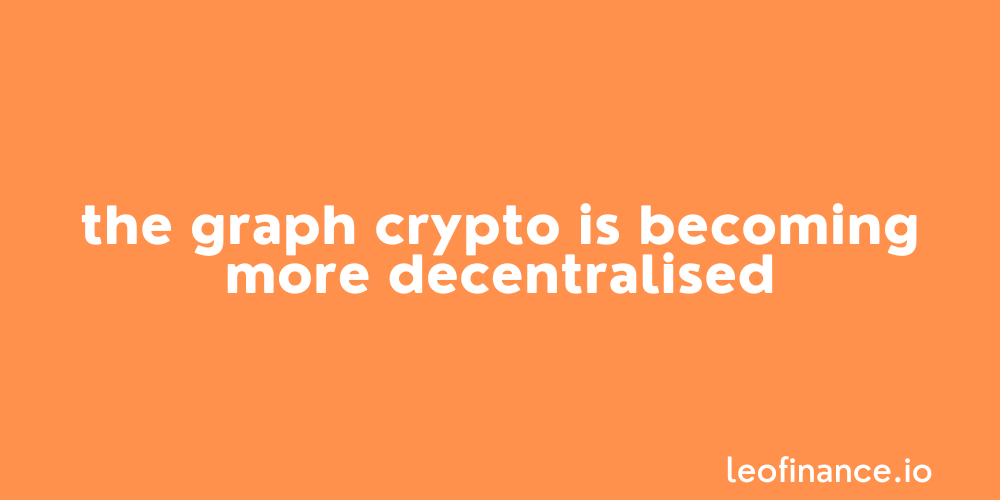The Graph crypto is becoming more decentralised

Direct from the desk of Dane Williams.
Now Chainstack has launched subgraphs, discover what this further decentralisation of The Graph means for GRT's future demand.
Chainstack has recently launched its own subgraph service for The Graph (GRT) ecosystem, providing a more decentralised option for developers to deploy subgraphs with less restrictions and limitations.
Moving away from the team’s ‘hosted service’ option, this is seen as a significant step towards The Graph's goal of becoming a fully decentralised indexing and query protocol.
However, the change in pricing from the GRT token to fiat currency has raised questions about the impact on the price of GRT.
On the blog today, I explore the implications of this further decentralisation of The Graph and what it may mean for GRT in the future.

What is the Graph crypto (GRT)?
The Graph is a decentralised indexing protocol that utilises GraphQL to simplify and accelerate developers' access to blockchain data.
Acting as a middleware layer between dApps and the blockchain, it enables developers to search then retrieve data in a more efficient way than previously possible.
The platform is built to address the challenge of data fragmentation in the blockchain ecosystem by providing a single, unified interface for accessing blockchain data.
This, in turn, reduces the time, effort and cost involved in building then maintaining decentralised applications.
Ultimately accelerating the growth and development of the entire blockchain ecosystem.
The Graph crypto (GRT) is the native token of the platform that's used to incentivise participants in the network to perform tasks such as querying, curating and indexing data.
It is a vital component that helps to ensure the platform's decentralisation and sustainability.
Chainstack launches subgraphs
Chainstack, a popular multi-cloud and multi-protocol infrastructure platform, has announced the launch of its own subgraph service for The Graph ecosystem.
The subgraph service is an important part of The Graph's decentralised indexing and query protocol.
Previously, The Graph's official 'hosted service' was the only option for deploying subgraphs and it was priced only in the GRT token.
This centralised approach meant that developers had to rely on The Graph team to host their subgraphs, which sometimes led to delays and higher costs.
However, with the recent launch of Chainstack's subgraph service, developers can now deploy their subgraphs on a more decentralised network.
One with fewer restrictions and limitations.
Fully priced in fiat.
This move raises the question of what effect this change will have on the demand for the GRT token, as it is no longer the sole currency for subgraph deployment.
Some may argue that this change in pricing may reduce demand for the GRT token.
However, the other side of the coin is that as a more decentralised network with more subgraphs could potentially increase the usage of The Graph protocol, it could actually increase demand.
Increased demand ultimately leading to a rising price for the GRT token.
The launch of Chainstack's subgraph service is a significant step towards The Graph's goal of becoming a fully decentralised indexing and query protocol.
A great first step toward decentralisation.
But still just a single step.
What does a more decentralised The Graph mean for GRT?
Having just touched on this point above, it deserves more discussion.
There’s no doubt that Chainstack's decision to charge users in fiat currency, instead of the GRT token, has raised some concerns about the future demand for the GRT token.
One of the benefits of using the GRT token was that it incentivised users to create and maintain subgraphs on The Graph network.
Now that users can pay with fiat currency, it is unclear how this will affect the demand for GRT.
However, it's worth noting that Chainstack's decision to charge in fiat currency is intended to make it easier for mid-tier or small-tier subgraphs to get indexed and discovered, which could actually lead to increased adoption and usage of the network overall.
Additionally, Chainstack has stated that they are not competing with The Graph and GRT token and even plan to participate in the decentralised network once they launch their service.
While there may be some concerns about the impact on the demand for GRT, it is too early to tell what the long-term effects will be.
As The Graph continues to decentralise and more developers and users join the network, it will become clearer how GRT will fit into the ecosystem.
Either way, this move toward decentralisation is a positive and something I’m happy to see.
Best of probabilities to you.
Posted Using LeoFinance Beta

I question their choice to price things in fiat and that doesn't bode well at all. It's a sign that they don't trust that GRT is a strong token at all.
Posted Using LeoFinance Beta
That's decentralisation for you.
Chainstack can do things how ever they want.
If it is bad for the token, it will be interesting to see if a different team comes in and offers a similar service, but pries it in GRT.
Interesting to watch it play out anyway.
Another good case study for future projects :)
Posted Using LeoFinance Beta
Decentralization is a key factor to build trust and I see that The Graph is on the right path. Let's see also if GRT will be able to capture that value.
Posted Using LeoFinance Beta
My big question is whether what's good for the tech itself, translates to a higher token price.
It's the same as the whole AI coin craze.
Like you don't need a coin to write good AI driven code.
So why are we so hell bent on intertwining the two?
Posted Using LeoFinance Beta